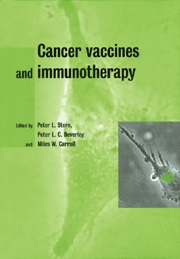Book contents
- Frontmatter
- Contents
- List of contributors
- 1 Immunity and cancer
- 2 Immunotherapy of bladder cancer
- 3 Poxviruses as vectors for cancer immunotherapy
- 4 Vaccinia-based human papillomavirus vaccines in cervical cancer
- 5 Vaccine delivery and immunosuppression in cervical cancer
- 6 Vaccines for colon cancer
- 7 MUC1 vaccines and breast cancer
- 8 Anti-idiotypic vaccination
- 9 Immunotherapy and vaccination against Epstein–Barr virus-associated cancer
- 10 Serologically identified tumour antigens as cancer vaccines
- 11 CTL-defined cancer vaccines in melanoma and other epithelial cancers
- 12 DNA vaccines against B-cell tumours
- 13 Dendritic cell approaches to immunotherapy
- 14 Overview
- 15 Recent developments
- Index
2 - Immunotherapy of bladder cancer
Published online by Cambridge University Press: 06 January 2010
- Frontmatter
- Contents
- List of contributors
- 1 Immunity and cancer
- 2 Immunotherapy of bladder cancer
- 3 Poxviruses as vectors for cancer immunotherapy
- 4 Vaccinia-based human papillomavirus vaccines in cervical cancer
- 5 Vaccine delivery and immunosuppression in cervical cancer
- 6 Vaccines for colon cancer
- 7 MUC1 vaccines and breast cancer
- 8 Anti-idiotypic vaccination
- 9 Immunotherapy and vaccination against Epstein–Barr virus-associated cancer
- 10 Serologically identified tumour antigens as cancer vaccines
- 11 CTL-defined cancer vaccines in melanoma and other epithelial cancers
- 12 DNA vaccines against B-cell tumours
- 13 Dendritic cell approaches to immunotherapy
- 14 Overview
- 15 Recent developments
- Index
Summary
Introduction
During recent years there have been major strides in our understanding of both the molecular basis of malignant disease and the cellular and molecular immunological response thereto. Nevertheless, despite these exciting developments, arguably the most successful immunotherapeutic approach for the treatment of any malignancy is the relatively unsophisticated approach, involving the intravesical administration of BCG in transitional cell carcinoma of the bladder. In this chapter we briefly describe the natural history of bladder cancer, the conventional treatments for this malignancy, the effects of BCG on the immune system and bladder cancer in vitro and in vivo, and speculate on its possible mode of action. Finally, we comment on the problems associated with this treatment and highlight current and future developments aimed at further improving the antitumour potential of BCG and other mycobacteria. For other excellent reviews in this area we would recommend Jackson and James, O'Donnell and DeWolf, Martinez-Pineiro and Martinez-Pineiro, Lamm, and Kurth.
Bladder cancer as a disease
Bladder cancer is the fourth most common cancer among men and the eighth most common among women. The annual incidence of bladder cancer in the USA is 54000 patients and the total number is currently estimated at 300000 (O'Donnell, personal communication). This results in over 11000 deaths a year. Females are relatively spared with a ratio of 1 to 3, possibly due to the different occupations and environments to which they are exposed.
- Type
- Chapter
- Information
- Cancer Vaccines and Immunotherapy , pp. 19 - 46Publisher: Cambridge University PressPrint publication year: 2000
- 2
- Cited by



